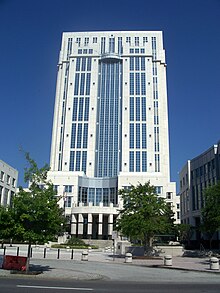Orange County, Florida
| Orange County, Florida | |||
|---|---|---|---|
| County | |||
| County of Orange | |||

The Orange County Courthouse in 2011
|
|||
|
|||
 Location in the U.S. state of Florida |
|||
 Florida's location in the U.S. |
|||
| Founded | 1845 | ||
| Named for | Orange fruit | ||
| Seat | Orlando | ||
| Largest city | Orlando | ||
| Area | |||
| • Total | 1,003 sq mi (2,598 km2) | ||
| • Land | 903 sq mi (2,339 km2) | ||
| • Water | 100 sq mi (259 km2) | ||
| Population (est.) | |||
| • (2015) | 1,288,126 | ||
| • Density | 1,249.25/sq mi (482/km²) | ||
| Congressional districts | 5th, 7th, 8th, 9th, 10th | ||
| Time zone | Eastern: UTC-5/-4 | ||
| Website | www |
||
Orange County is a county in the state of Florida, in the United States. As of the 2010 census, the population was 1,145,956, making it Florida's fifth-most populous county. The county seat is Orlando.
Orange County is the central county Orlando-Kissimmee-Sanford, Florida Metropolitan Statistical Area.
The land that is Orange County was part of the first land to emerge from below the Early Oligocene sea 33.9–28.4 million years ago and is known as Orange Island. Orange County's Rock Spring location is a fossil bearing area and has yielded a vast variety of birds and mammals including giant sloth, mammoth, camel, and the dire wolf dating around 1.1 million years ago.
In 1821, two counties formed Florida: Escambia to the west and St. Johns to the east. In 1824, the area to the south of St. Johns County became Mosquito County, and Enterprise was named the county seat. This massive county took up much of central Florida. Mosquito County was renamed Orange County in 1845 when Florida became a state. Several counties, such as Osceola, Seminole, Lake, and Volusia were carved out of Orange County.
...
Wikipedia


